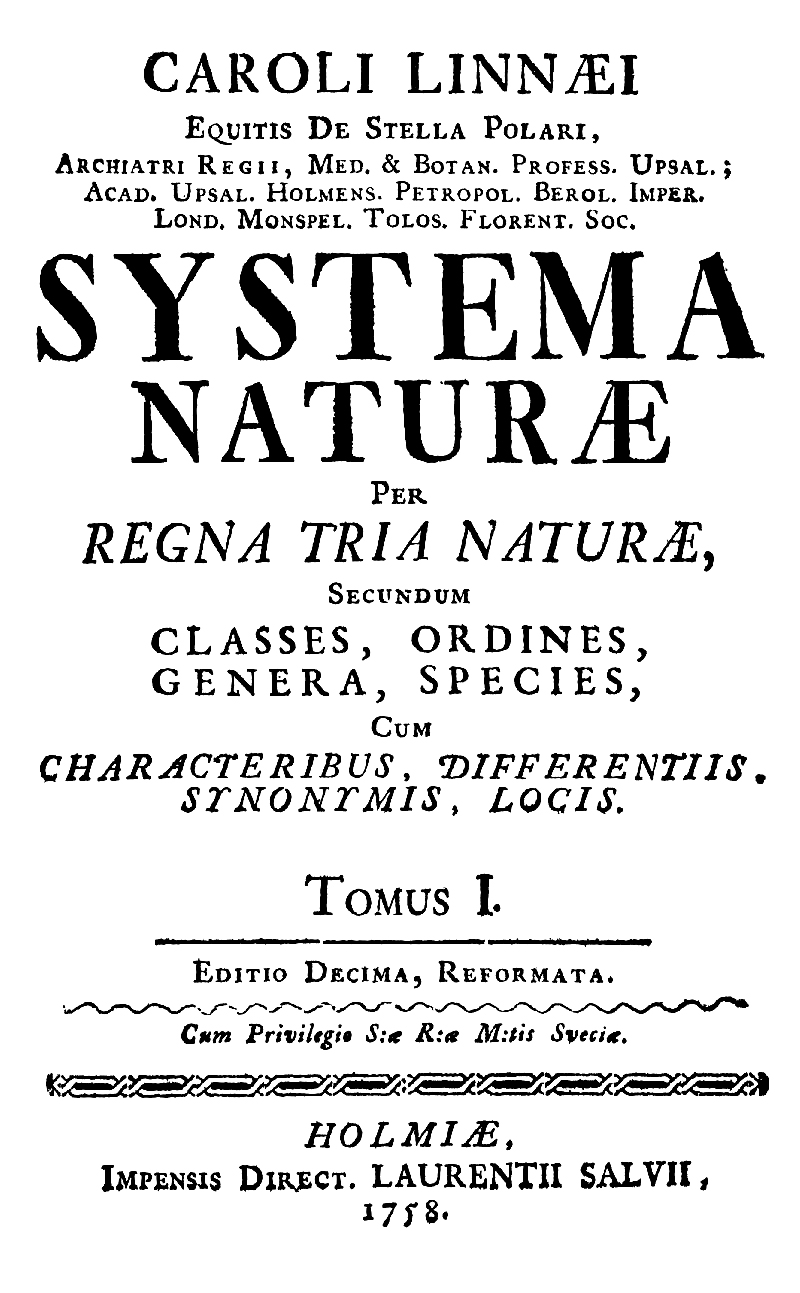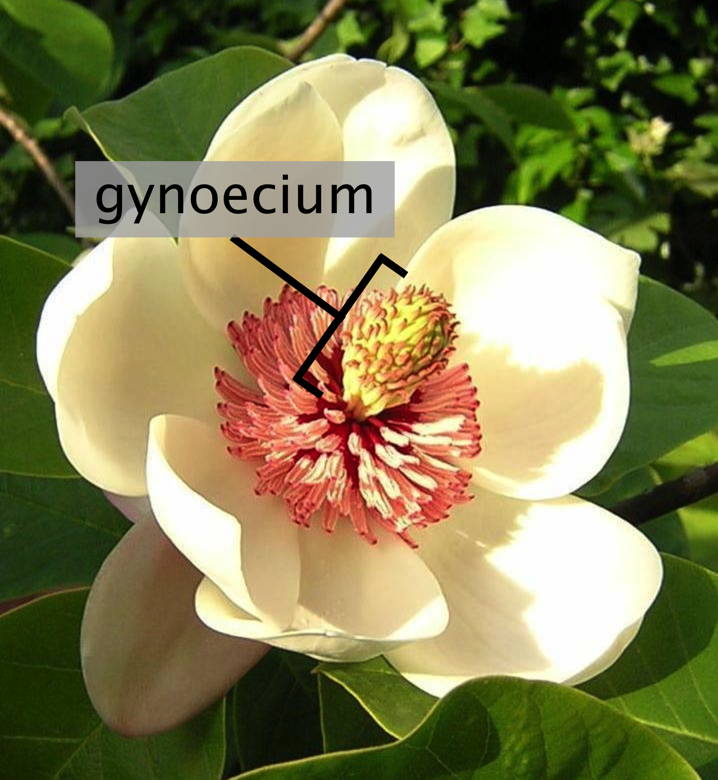|
Linnaean Taxonomy
Linnaean taxonomy can mean either of two related concepts: # The particular form of biological classification (taxonomy) set up by Carl Linnaeus, as set forth in his ''Systema Naturae'' (1735) and subsequent works. In the taxonomy of Linnaeus there are three kingdoms, divided into ''classes'', and the classes divided into lower ranks in a hierarchical order. # A term for rank-based classification of organisms, in general. That is, taxonomy in the traditional sense of the word: rank-based scientific classification. This term is especially used as opposed to cladistic systematics, which groups organisms into clades. It is attributed to Linnaeus, although he neither invented the concept of ranked classification (it goes back to Plato and Aristotle) nor gave it its present form. In fact, it does not have an exact present form, as "Linnaean taxonomy" as such does not really exist: it is a collective (abstracting) term for what actually are several separate fields, which use similar a ... [...More Info...] [...Related Items...] OR: [Wikipedia] [Google] [Baidu] [Amazon] |
Order (biology)
Order () is one of the eight major hierarchical taxonomic ranks in Linnaean taxonomy. It is classified between family and class. In biological classification, the order is a taxonomic rank used in the classification of organisms and recognized by the nomenclature codes. An immediately higher rank, superorder, is sometimes added directly above order, with suborder directly beneath order. An order can also be defined as a group of related families. What does and does not belong to each order is determined by a taxonomist, as is whether a particular order should be recognized at all. Often there is no exact agreement, with different taxonomists each taking a different position. There are no hard rules that a taxonomist needs to follow in describing or recognizing an order. Some taxa are accepted almost universally, while others are recognized only rarely. The name of an order is usually written with a capital letter. For some groups of organisms, their orders may follow consist ... [...More Info...] [...Related Items...] OR: [Wikipedia] [Google] [Baidu] [Amazon] |
Plant Sexual Morphology
Plant reproductive morphology is the study of the physical form and structure (the Plant morphology, morphology) of those parts of plants directly or indirectly concerned with sexual reproduction. Among all living organisms, flowers, which are the reproductive structures of flowering plant, angiosperms, are the most varied physically and show a correspondingly great diversity in methods of reproduction. Plants that are not flowering plants (green algae, mosses, Marchantiophyta, liverworts, hornworts, ferns and gymnosperms such as conifers) also have complex interplays between morphological adaptation and environmental factors in their sexual reproduction. The breeding system, or how the sperm from one plant fertilizes the Egg cell, ovum of another, depends on the reproductive morphology, and is the single most important determinant of the genetic structure of nonclonal plant populations. Christian Konrad Sprengel (1793) studied the reproduction of flowering plants and for the ... [...More Info...] [...Related Items...] OR: [Wikipedia] [Google] [Baidu] [Amazon] |
Dioecious
Dioecy ( ; ; adj. dioecious, ) is a characteristic of certain species that have distinct unisexual individuals, each producing either male or female gametes, either directly (in animals) or indirectly (in seed plants). Dioecious reproduction is biparental reproduction. Dioecy has costs, since only the female part of the population directly produces offspring. It is one method for excluding self-fertilization and promoting allogamy (outcrossing), and thus tends to reduce the expression of recessive deleterious mutations present in a population. Plants have several other methods of preventing self-fertilization including, for example, dichogamy, herkogamy, and self-incompatibility. In zoology In zoology, dioecy means that an animal is either male or female, in which case the synonym gonochory is more often used. Most animal species are gonochoric, almost all vertebrate species are gonochoric, and all bird and mammal species are gonochoric. Dioecy may also describe colonies ... [...More Info...] [...Related Items...] OR: [Wikipedia] [Google] [Baidu] [Amazon] |
Monoecious
Monoecy (; adj. monoecious ) is a sexual system in seed plants where separate male and female cones or flowers are present on the same plant. It is a monomorphic sexual system comparable with gynomonoecy, andromonoecy and trimonoecy, and contrasted with dioecy where individual plants produce cones or flowers of only one sex and with bisexual or hermaphroditic plants in which male and female gametes are produced in the same flower. Monoecy often co-occurs with anemophily, because it prevents self-pollination of individual flowers and reduces the probability of self-pollination between male and female flowers on the same plant. Monoecy in Flowering plant, angiosperms has been of interest for evolutionary biologists since Charles Darwin. Terminology Monoecious comes from the Greek words for one house. History The term monoecy was first introduced in 1735 by Carl Linnaeus. Darwin noted that the flowers of monoecious species sometimes showed traces of the opposite sex function, ... [...More Info...] [...Related Items...] OR: [Wikipedia] [Google] [Baidu] [Amazon] |
Receptacle (botany)
In botany, the receptacle refers to vegetative tissues near the end of reproductive stems that are situated below or encase the reproductive organs. Angiosperms In angiosperms, the receptacle or torus (an older term is thalamus, as in Thalamiflorae) is the thickened part of a stem (pedicel) from which the flower organs grow. In some accessory fruits, for example the pome and strawberry, the receptacle gives rise to the edible part of the fruit. The fruit of ''Rubus'' species is a cluster of drupelets on top of a conical receptacle. When a raspberry is picked, the receptacle separates from the fruit, but in blackberries, it remains attached to the fruit. — In the daisy family (Compositae or Asteraceae), small individual flowers are arranged on a round or dome-like structure that is also called receptacle. Algae and bryophyta In phycology, receptacles occur at the ends of branches of algae mainly in the brown algae Brown algae (: alga) are a large group of multice ... [...More Info...] [...Related Items...] OR: [Wikipedia] [Google] [Baidu] [Amazon] |
Ovary (plants)
In the flowering plants, an ovary is a part of the female reproductive organ of the flower or gynoecium. Specifically, it is the part of the pistil which holds the ovule(s) and is located above or below or at the point of connection with the base of the petals and sepals. The pistil may be made up of one carpel or of several fused carpels (e.g. dicarpel or tricarpel), and therefore the ovary can contain part of one carpel or parts of several fused carpels. Above the ovary is the style and the stigma, which is where the pollen lands and germinates to grow down through the style to the ovary, and, for each individual pollen grain, to fertilize one individual ovule. Some wind pollinated flowers have much reduced and modified ovaries. Fruits A fruit is the mature, ripened ovary of a flower following double fertilization in an angiosperm. Because gymnosperms do not have an ovary but reproduce through fertilization of unprotected ovules, they produce naked seeds that do ... [...More Info...] [...Related Items...] OR: [Wikipedia] [Google] [Baidu] [Amazon] |
Kalmia Latifolia Great Smoky
''Kalmia'' is a genus of about ten species of evergreen shrubs from 0.2–5 m tall, in the family Ericaceae (heath). They are native to North America (mainly in the eastern half of the continent) and Cuba. They grow in acidic soils, with different species in wet acid bog habitats (''K. angustifolia, K. polifolia'') and dry, sandy soils (''K. ericoides, K. latifolia''). ''Kalmia'' was named by Linnaeus to honour his friend the botanist Pehr Kalm, who collected it in eastern North America during the mid-18th century. Earlier, Mark Catesby saw it during his travels in Carolina, and after his return to England in 1726, imported seeds. He described it, a costly rarity, in his ''Natural History of Carolina'', as ''Chamaedaphne foliis tini'', that is to say "with leaves like the Laurustinus"; the botanist and plant-collector Peter Collinson, who had begged some of the shrub from his correspondent John Custis in Virginia, wrote, when his plants flowered, that "I Really Think it exce ... [...More Info...] [...Related Items...] OR: [Wikipedia] [Google] [Baidu] [Amazon] |
Gynoecium
Gynoecium (; ; : gynoecia) is most commonly used as a collective term for the parts of a flower that produce ovules and ultimately develop into the fruit and seeds. The gynoecium is the innermost whorl (botany), whorl of a flower; it consists of (one or more) ''#Pistil, pistils'' and is typically surrounded by the pollen-producing plant reproductive morphology, reproductive organs, the stamens, collectively called the androecium. The gynoecium is often referred to as the "female" portion of the flower, although rather than directly producing female gametes (i.e. egg cells), the gynoecium produces megaspores, each of which develops into a female gametophyte which then produces egg cells. The term gynoecium is also used by botanists to refer to a cluster of archegonia and any associated modified leaves or stems present on a gametophyte shoot in mosses, Marchantiophyta, liverworts, and hornworts. The corresponding terms for the male parts of those plants are clusters of antheridiu ... [...More Info...] [...Related Items...] OR: [Wikipedia] [Google] [Baidu] [Amazon] |
Stamen
The stamen (: stamina or stamens) is a part consisting of the male reproductive organs of a flower. Collectively, the stamens form the androecium., p. 10 Morphology and terminology A stamen typically consists of a stalk called the filament and an anther which contains sporangium, microsporangia. Most commonly, anthers are two-lobed (each lobe is termed a locule) and are attached to the filament either at the base or in the middle area of the anther. The sterile (i.e. nonreproductive) tissue between the lobes is called the Connective (botany), connective, an extension of the filament containing conducting strands. It can be seen as an extension on the dorsal side of the anther. A pollen grain develops from a microspore in the microsporangium and contains the male gametophyte. The size of anthers differs greatly, from a tiny fraction of a millimeter in ''Wolfia'' spp up to five inches (13 centimeters) in ''Canna iridiflora'' and ''Strelitzia nicolai''. The stamens in a flower ... [...More Info...] [...Related Items...] OR: [Wikipedia] [Google] [Baidu] [Amazon] |
Philosophia Botanica
''Philosophia Botanica'' ("Botanical Philosophy", ed. 1, Stockholm & Amsterdam, 1751.) was published by the Swedish naturalist and physician Carl Linnaeus (1707–1778) who greatly influenced the development of botanical Taxonomy (biology), taxonomy and systematics in the 18th and 19th centuries. It is "the first textbook of descriptive systematic botany and botanical Latin". It also contains Linnaeus's first published description of his binomial nomenclature. ''Philosophia Botanica'' represents a maturing of Linnaeus's thinking on botany and its theoretical foundations, being an elaboration of ideas first published in his ''Fundamenta Botanica'' (1736) and ''Critica Botanica'' (1737), and set out in a similar way as a series of stark and uncompromising principles (aphorismen). The book also establishes a basic botanical terminology. The following principle §79 demonstrates the style of presentation and Linnaeus's method of introducing his ideas. A detailed analysis of the w ... [...More Info...] [...Related Items...] OR: [Wikipedia] [Google] [Baidu] [Amazon] |







